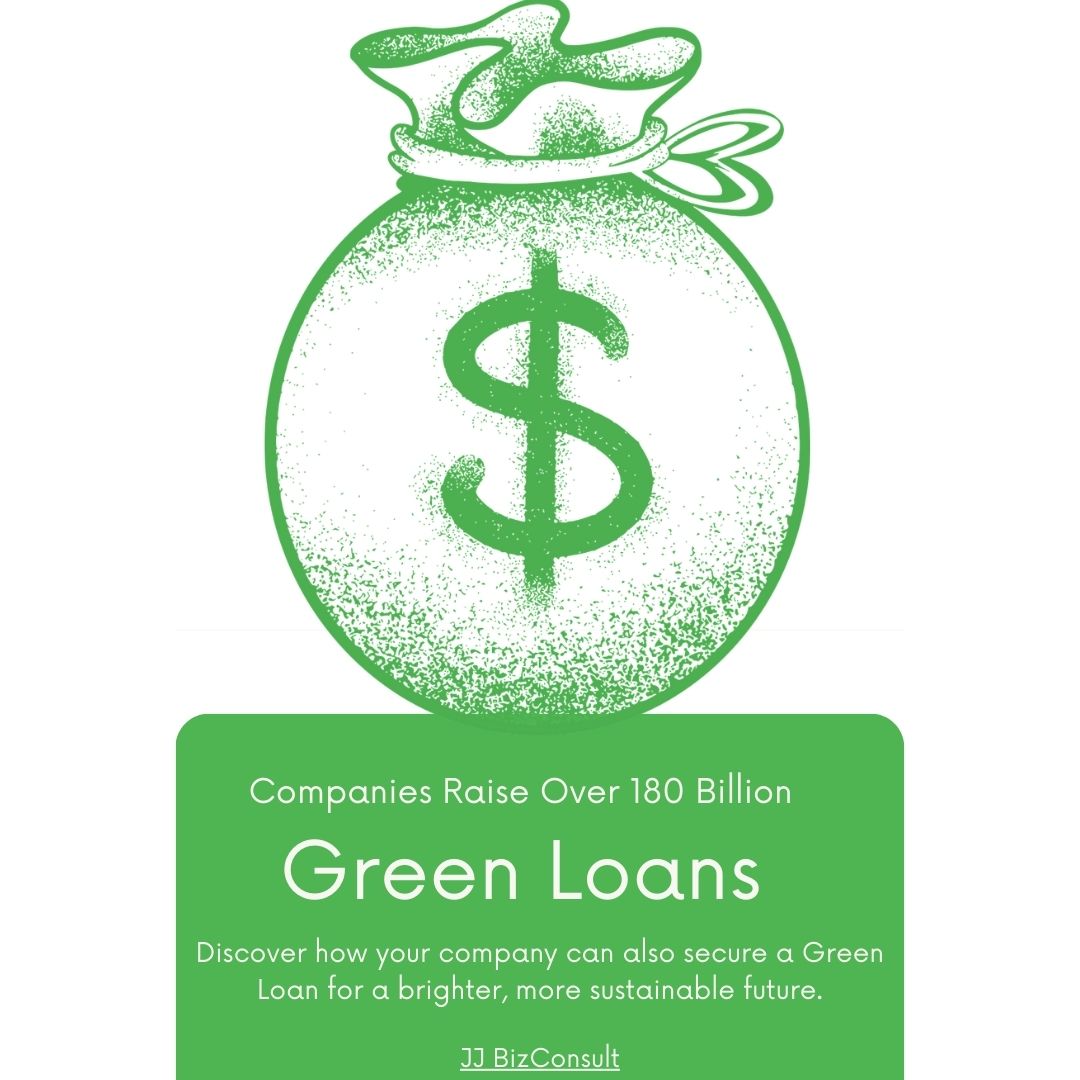Green Loans: Companies Raise Over 180 Billion Know It All

Green Loans: Companies Raise Over 180 Billion Know It All.
Introduction: Green Loans
In recent years, the financial world has witnessed a significant shift towards sustainability and environmental responsibility. This shift is most evident in the realm of corporate finance, where companies are increasingly turning to Green Loans and Sustainability-Linked Loans (SLLs) to fund their environmentally friendly initiatives. In 2020, companies globally raised over $180 billion through these green and sustainable financing options, a staggering increase from the mere $5 billion raised in 2017. This growing trend is not limited to Europe, where the majority of such financing currently takes place, but is spreading across the globe, signaling a fundamental change in how businesses approach capital acquisition.

Green Loans and Sustainability-Linked Loans: Understanding the Basics
To comprehend the significance of Green Loans and Sustainability-Linked Loans, it’s essential to grasp their core principles. The Loan Market Association (LMA) played a pivotal role in defining these principles in the UK. In 2018, the LMA published the principles for Green Loans, which mandate that funds be used explicitly for a green purpose. Meanwhile, in 2019, the LMA released guidelines for SLLs, also known as ESG Loans or KPI Loans, which focus on helping borrowers improve their sustainability profiles by setting sustainability-linked performance metrics. Both these loan types offer financial incentives to borrowers for achieving specific green or sustainable targets while imposing financial penalties for failing to meet these targets, often in the range of 5-10 basis points.
However, a challenge associated with these financing options is the potential for greenwashing or sustainability washing, where borrowers might exaggerate their environmental efforts to secure cheaper loans. To address this concern, lenders must develop robust systems to appropriately audit and verify the metrics put forth by borrowers.
The Evolution of ESG Alternatives
The establishment of the Green Bond Principles, LMA’s Green Loan Principles, and SLL Principles has not only provided a framework for ESG bonds and loans but has also influenced the development of other financial products. One notable example is the Sustainability-Linked Bond, which combines elements from SLLs with a fixed income product. ICMA published principles for this market in June 2020, and it is anticipated that the market size for these issuances will reach approximately $125 billion by the end of 2021. Unlike green or social bonds, these bonds do not require a clear expenditure purpose but instead align with SLLs and Green Loans by reporting on key performance indicators (KPIs). External parties are often enlisted to assess and review changes to these KPIs, ensuring transparency and accountability.
Additionally, other financial products, such as Schuldscheine and private placements, have also embraced ESG formats. Schuldscheine, a medium to long-term bond-like product, can exist in both green “purpose” and “sustainability-linked” formats, aligning with the reporting mechanisms seen in Green Loans and SLLs. Presently, between 10 and 15% of Schuldscheine issuances follow an ESG format.
Private placement markets are steadily evolving and, as of the beginning of 2020, represented 9% of all sustainability-labelled debt. While Europe leads in private placement issuances, the US is catching up, albeit at a slower pace. Longer-term maturities in the US private placement market make it challenging to establish meaningful key performance indicators for tracking a company’s sustainability efforts. However, as institutional investors increasingly prioritize ESG products, it’s likely that the US private placement market will expand in the coming years.
The Future of ESG Products
As investor interest in ESG products continues to grow, Collateralized Loan Obligations (CLOs) are also expected to become more prevalent. Currently, negative screening against industries such as oil and gas, tobacco, and gambling is the primary method for differentiating ESG-compliant products from others. However, the market is expected to become more sophisticated over time, with investors seeking a broader range of ESG criteria to guide their investment decisions.
In conclusion, the rise of Green Loans, Sustainability-Linked Loans, and other ESG financing options represents a transformative shift in the world of corporate finance. Companies are not only seeking capital to fund their green initiatives but are also aligning their financial strategies with sustainability goals. As the financial industry continues to evolve and refine these ESG products, they will likely play an increasingly significant role in shaping the future of finance, driving both environmental responsibility and financial success.
Note: This blog post provides insights into the world of Green Loans and Sustainability-Linked Loans, along with related ESG financing options. It highlights the growth of these financial products and the need for transparency and accountability in sustainability reporting. The post also discusses the potential for further development and sophistication in the ESG finance market, including the role of Collateralized Loan Obligations (CLOs) and evolving criteria for ESG compliance.
Source: WorldFinancialReview
Unlock Sustainable Growth with “Developing an Effective ESG Strategy”
In an era where societal and environmental challenges are at the forefront of global consciousness, businesses are increasingly recognizing the need to embrace sustainability as a core value. The concept of Environmental, Social, and Governance (ESG) has emerged as a guiding framework for organizations seeking to make a positive impact on the world while driving long-term success. From investors to consumers, stakeholders across the board are demanding greater accountability and responsibility from businesses, expecting them to address pressing societal problems.
“Developing an Effective ESG Strategy: A Blueprint for Sustainable Success” is more than just a book; it’s a valuable roadmap to navigate the complex landscape of ESG and unlock the potential for sustainable growth. For any company or entrepreneur, this book is an invaluable resource that can not only transform your organization but also help you secure financing through ESG-focused loans.
Drawing upon extensive research and best practices, this book offers a step-by-step approach to building an ESG strategy that goes beyond mere compliance and tick-box exercises. It empowers you to integrate sustainability principles into the very fabric of your organization, allowing you to thrive in a rapidly changing world while making a positive impact.
Here’s what you can expect from this comprehensive guide:
- Assessment and Alignment: Learn how to conduct a comprehensive assessment of your organization’s current ESG performance. Identify strengths and weaknesses, and align your priorities with your industry context. This strategic alignment is key to securing ESG loans and investments.
- Setting Measurable Goals: Gain insights into setting measurable ESG goals that resonate with your organization’s values, mission, and purpose. Clear objectives not only guide your sustainability efforts but also attract investors who seek tangible outcomes.
- Stakeholder Engagement: Discover the importance of engaging stakeholders in your ESG journey. Effective stakeholder engagement not only enhances your ESG strategy but also strengthens your relationship with potential lenders.
- Governance and Integration: Establish robust governance structures and integrate ESG considerations into all aspects of your operations. A well-governed organization is more likely to secure financing, as it demonstrates commitment and responsibility.
- Transparent Reporting: Emphasize the significance of transparent reporting and continual improvement. This book provides guidance on effective measurement, reporting frameworks, and staying ahead of evolving trends and regulations, which are crucial for attracting ESG-focused investors.
“Developing an Effective ESG Strategy” showcases the power of ESG to create a sustainable future for organizations and the world. It highlights the immense opportunities that lie in aligning business strategies with sustainability principles.
Whether you are an executive, sustainability professional, or a business leader seeking to embark on an ESG journey, this book will equip you with the knowledge, tools, and inspiration to navigate this transformative path. It empowers you to build a resilient and responsible organization that not only contributes to a better world but also enjoys long-term success in an increasingly sustainability-driven marketplace.
Join us on this journey to develop an ESG strategy that not only meets stakeholder expectations but also fuels your organization’s growth and impact. Together, let’s unlock the full potential of sustainability and embrace a future where businesses thrive while creating positive change.
Order “Developing an Effective ESG Strategy: A Blueprint for Sustainable Success” on Amazon now and embark on your journey to sustainable growth and ESG success.

Walmart InHome Delivery: The Future of Grocery Shopping Is Here




